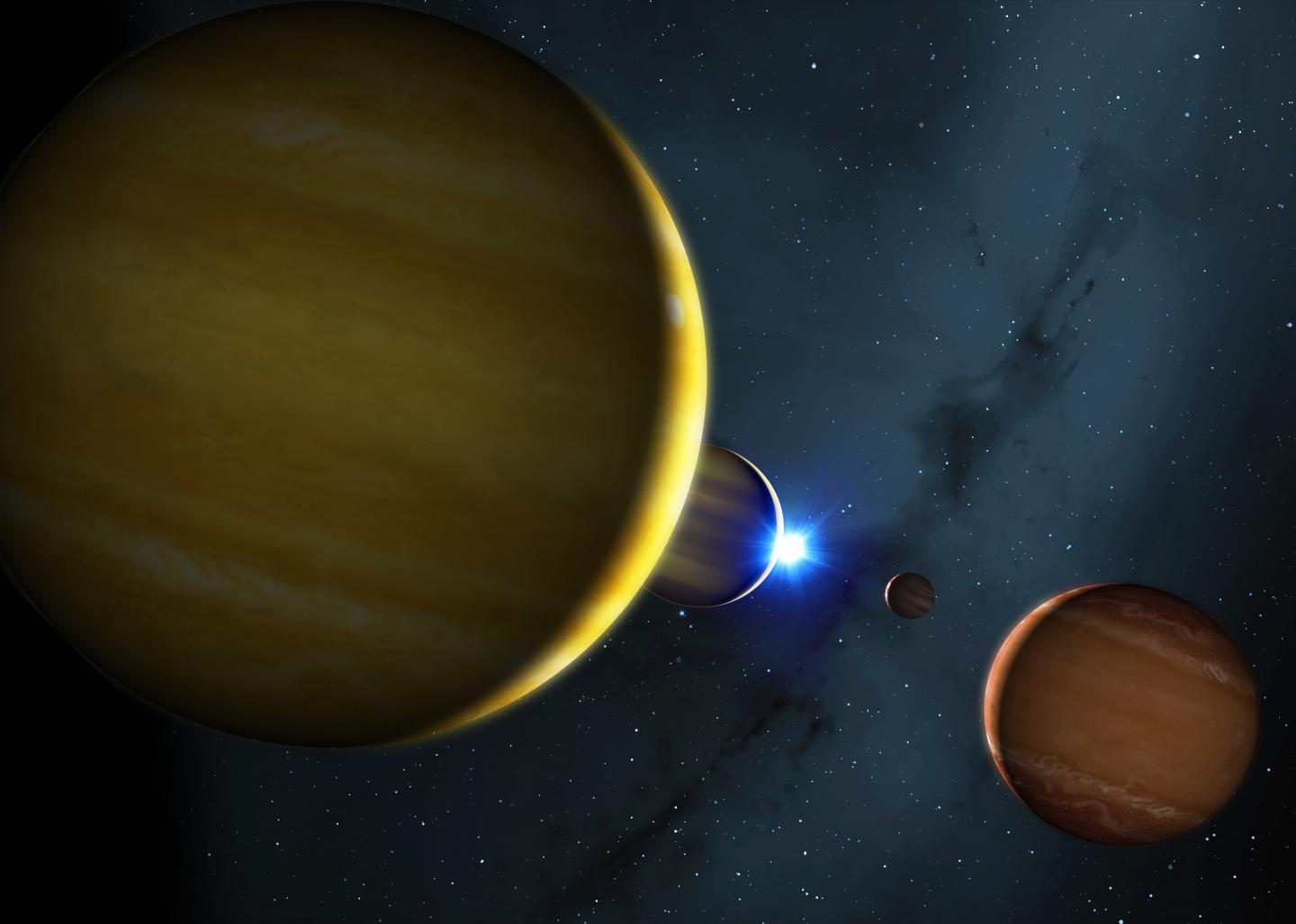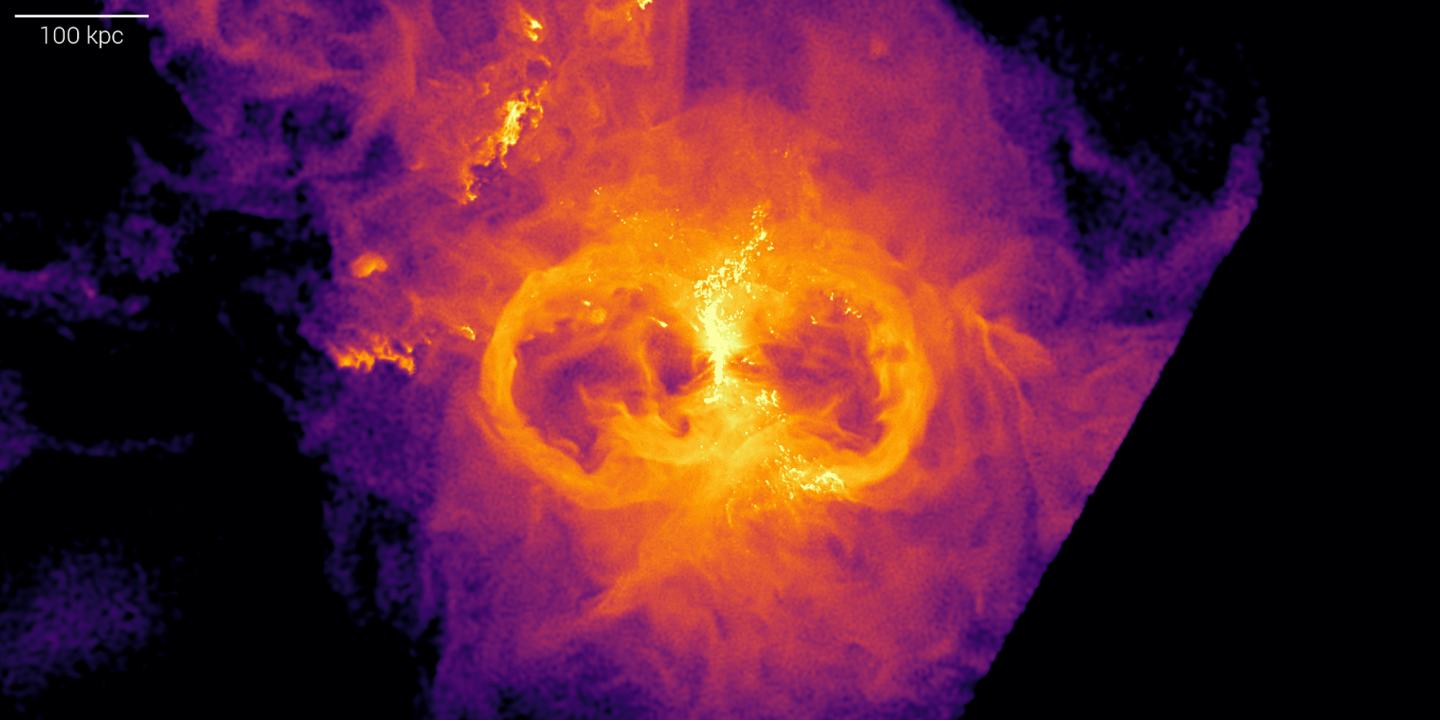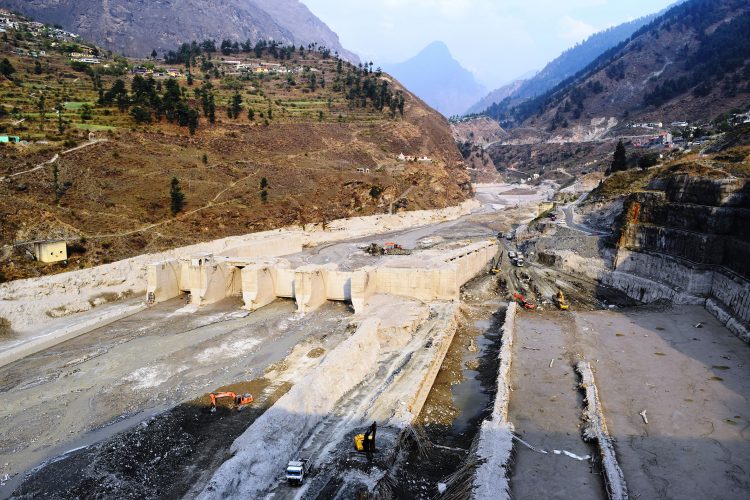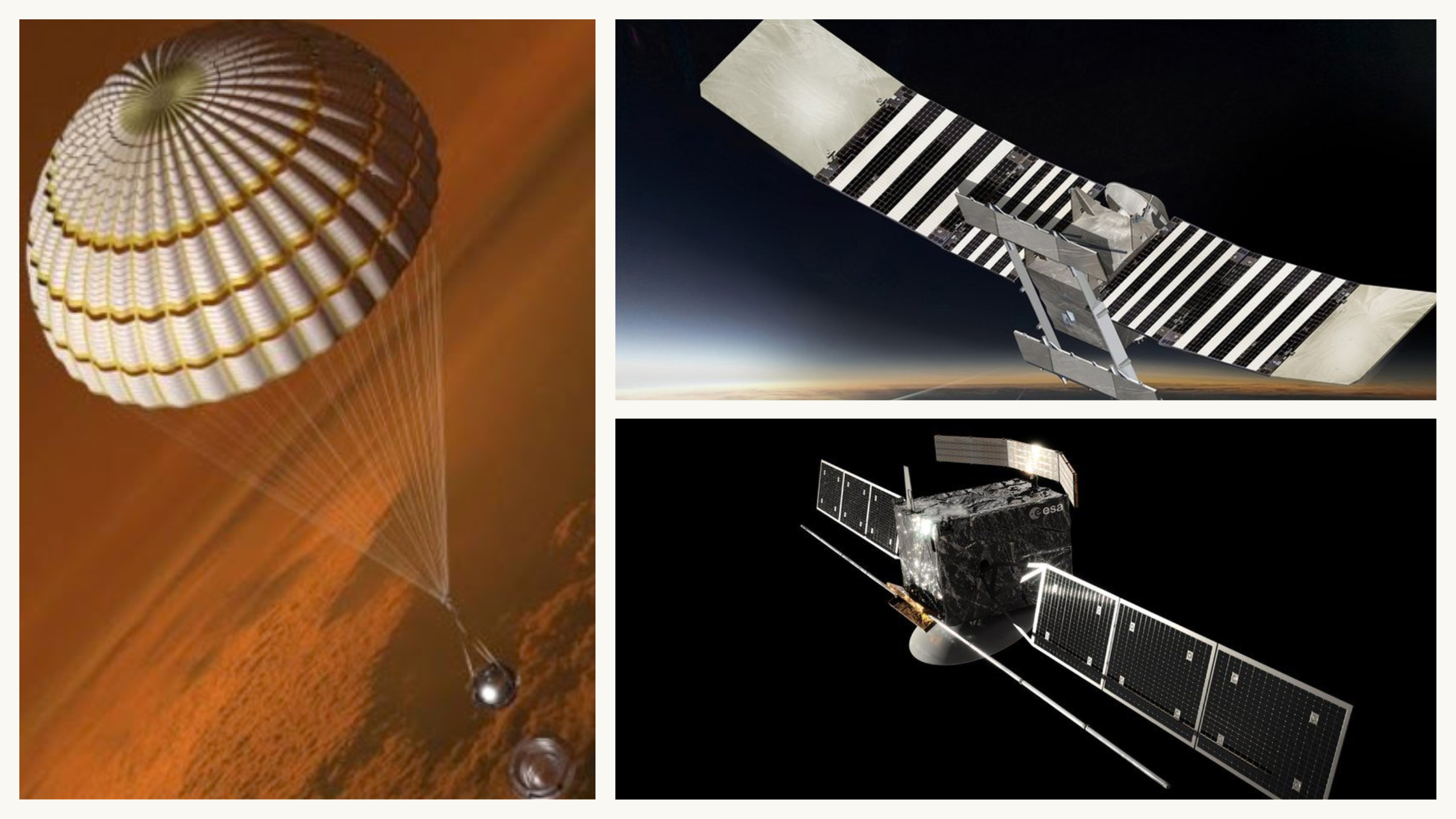Contrary to the destructive role supermassive black holes are thought to play in the lives of stars, it turns out that certain types of galaxies benefit from black holes clearing the way and keeping star formation going. Plus, lightning at the edge of space, a landslide in the Himalayas, and an interview with Dr. Darby Dyar and Dr. David Grinspoon about the recent selection of three different Venus missions.
Podcast
Transcript
Hello and welcome to the Daily Space. I am your host Dr. Pamela Gay.
And I am your host Beth Johnson.
And we are here to put science in your brain.
We periodically get to share news stories about solar systems where planets or moons orbit in cool rhythms. In our own solar system, the Galilean moons of Jupiter have their own syncopated beat, with Ganymede taking the bass line and orbiting once for every two Europa orbits and four Io orbits.

This kind of a rhythm occurs all over space, and one particular system, HR 8799, recently caught the attention of researchers Dimitri Veras and Sasha Hinkley who decided to see what will happen as this system’s central star evolves. As it stands, the system’s four worlds orbit in an 8 to 4 to 2 to 1 resonance, but as the system’s bright, hot, A-type star loses mass, those orbits will expand, and the planets, all larger than Jupiter, will violently interact as they drift a bit too close together and gravitationally fling one another around like planetary nunchucks.
The details of what will go down weren’t actually possible because changing planetary positions by even a centimeter at the beginning of the model would lead to massive differences at the end of the model, and if those worlds have moons, their actual positions may wander significantly more than a centimeter!
According to Veras, the planets are so big and so close to each other the only thing that’s keeping them in this perfect rhythm right now is the locations of their orbits. All four are connected in this chain. As soon as the star loses mass their locations will deviate, then two of them will scatter off one another, causing a chain reaction amongst all four.
I have to admit, I now really want a Star Trek episode or something about a star system ending this way. Science fiction writers, you have your prompt!
The Universe is a destructive place, and we like to remind folks that the Universe is always trying to kill us. Sometimes, however, things you might only expect to cause destruction can actually trigger creation. For instance, black holes.

In new research appearing in the journal Nature and led by Ignacio Martín-Navarro, researchers describe how the flares and outbursts of supermassive black holes in the centers of large galaxies can clear the way for orbiting dwarf systems to form stars. Normally, these small, low-mass systems charge into the thin gas on the outskirts of massive galaxies and experience an effect called Ram Pressure Stripping. Essentially, it’s like holding a dandelion gone to seed out the window of a car and watching it get stripped of its fluff: the gas just pushes everything not held tightly out of the system. When black holes misbehave and outburst, however, they push all that thin gas out of the region above and below a galaxy, allowing the satellite galaxies in polar orbits to keep forming stars.
So there you go. One black hole’s destruction means surviving star formation for passing dwarfs with just the right orbit.
Destruction is a terrible motivator for science, but it does motivate science. Recently, a huge mass wasting event in India destroyed two hydropower facilities and resulted in the deaths of nearly 200 people. Shocking and tragic, scientists raced to understand how and why this event occurred and if it could be prevented in the future.
Over fifty scientists came together to study the landslide, which began when a wedge of rock under a glacier broke off a ridge in the Himalayas. All that rock and ice fell downhill, carrying debris with it, and the damage was extensive. Using a combination of satellite images, eyewitness videos, and seismic data, the team worked to produce computer models of the debris flow.

At first, it was thought that a glacial lake burst through its barrier and flooded the region, but the images revealed no glacier lakes large enough to flood the site. They eventually traced the slide back to a scar that was missing enough rock and ice to cover Washington, D.C. in a half-foot-deep layer. The drop from the ridge was over a mile, and the glacial ice melted as the block fell, causing the resulting flooding that destroyed the power plants.
The real culprit is likely climate change, and the images showed that several other large masses of ice had broken off and fallen in recent years in the same valley, and the frequency of such events is increasing. More study is needed to determine how to prevent such tragedies in the future. The work was published in the journal Science.
As spring moves to summer, many places are finally seeing this year’s thunderstorm and tornado season come to an end. While there are few things as beautiful as a massive storm sprawling across an empty landscape, the storms don’t stick to the empty places and can cause destruction and even death. A few years ago, I got caught in a tornado, hiding at a gas station. While I was ok, a two-mile-long swath of destruction passed through my neighborhood, and this year we’ve already seen recordings of this show impacted by the weather I face in the midwest. As bad as it can be on the ground, we’re now learning these storms can trigger events through all layers of the atmosphere.

In a new study appearing in JGR: Atmospheres, researchers led by Nikolai Ostgaard observed storms using optical and gamma-ray detectors near Arecibo Observatory in Puerto Rico. This work was done in collaboration with the Atmosphere-Space Interactions Monitor on the ISS. They found that terrestrial gamma-ray flashes occur just as a positive intracloud lightning flash takes place.
Along with this invisible, high-energy burst, detectors on the ISS above the storm were able to see a feature called an ELVE, which are emissions associated with electromagnetic pulses. Just 456 milliseconds later, another ELVE was produced with a negative cloud-to-ground lightning flash, 300 kilometers away. This research is stunning and makes it clear that to really understand storms, we need to be observing them from above and below at the same time.
This research also reminds us that while the Arecibo radio observatory may be broken beyond repair, the other scientific equipment at the facility is still doing great science.
In a second lightning study, this one appearing in Scientific Reports and led by Caitano daSilva, researchers using that same facility in Puerto Rico studied how lightning and solar flares can interact as they zot the atmosphere from above and below. According to the press release, this first-of-a-kind study determined that lightning from thunderstorms trigger unique changes to that edge of space, which is used for long-range communications such as the GPS found in vehicles and airplanes.
Put another way, lightning strikes and solar flares can work together to totally screw up GPS and communications. This is actually pretty devastating news. There have been past instances of hurricanes striking just as solar flares wrecked communications in many shortwave bands. Now we’re seeing how lightning wrecks other bands and how these events work together to be more than the sum of their parts. According to da Silva: One of the key things we showed in the paper is that lightning- and solar flare-driven signatures are completely different. … This study helps emphasize that, in order to fully understand the coupling of atmospheric regions, energy input from below (from thunderstorms) into the lower ionosphere needs to be properly accounted for.
It’s hoped that this research will make it one day possible to develop communications equipment that works even in the worst combinations of lightning and solar flares. As we move into a more active period of the sun and we experience more active hurricanes than ever before, these results from Arecibo could help save lives.

Earlier this month, we had the pleasure of hosting the State of NASA stream where NASA Administrator Bill Nelson announced the selection of two Discovery-class missions to Venus. The first, DAVINCI+, will have a descent sphere that plunges through the atmosphere and measures the composition. It will also take high-resolution pictures of the surface to determine if Venus had plate tectonics and/or an ocean. The second mission is VERITAS, which is an orbiter that will map out the surface geology using synthetic aperture radar and determine the rock types with infrared instruments.
Then, in a surprise twist, last week, the European Space Agency announced the selection of their fifth Medium-class mission, EnVision, which is going to Venus as well. Also an orbiter, EnVision intends to gather data about everything from the inner core to the upper atmosphere of our harsh sister planet. All of these missions will help us gain an understanding of just how Venus formed and evolved and why it did so differently than Earth.
Joining me now are two scientists from the Planetary Science Institute. Dr. Darby Dyar is a senior scientist and a deputy principal investigator for the VERITAS mission. Dr. David Grinspoon is also a senior scientist and a co-investigator for the DAVINCI+ mission. Both have spent the last decade pushing for a return to Venus, and I know they are incredibly excited about their mission selections.
Thank you both for being here today.
[Interview]
For now, though, this has been the Daily Space.
Learn More
Dying Stars Cause Planets to Lose Their Rhythm
- Warwick University press release
- “The post-main-sequence fate of the HR 8799 planetary system,” Dimitri Veras and Sasha Hinkley, 2021 May 14, Monthly Notices of the Royal Astronomical Society
Black Holes Can Trigger Gas to Collapse Into Stars
- Max Planck Institute press release
- “Anisotropic satellite galaxy quenching modulated by black hole activity,” Ignacio Martín-Navarro et al., 2021 June 9, Nature
Geology Explains Destructive Debris Flow
- PSI press release
- ESA press release
- University of Washington press release
- “A massive rock and ice avalanche caused the 2021 disaster at Chamoli, Indian Himalaya,” D. H. Shugar et al., 2021 June 10, Science
Lightning Does More Than Light the Sky
- UCF press release
- Observations from Space and Ground Reveal Clues About Lightning (Eos)
- “Survey of electron density changes in the daytime ionosphere over the Arecibo observatory due to lightning and solar flares,” Caitano L. da Silva, Sophia D. Salazar, Christiano G. M. Brum, and Pedrina Terra, 2021 May 13, Scientific Reports
- “Simultaneous Observations of EIP, TGF, Elve, and Optical Lightning,” N. Østgaard et al., 2021 April 15, JGR: Atmospheres
Trio of Missions Now Set to Explore Venus
- NASA JPL press release
- ESA press release
- Return to Hell: NASA Selects Two Missions to Venus to Explore the Pathway to Habitability (Many Worlds)
- And Then There Were Three: ESA Follows NASA in Selecting a Mission to Venus (Many Worlds)
Credits
Written by Pamela Gay and Beth Johnson
Hosted by Pamela Gay and Beth Johnson
Audio and Video Editing by Ally Pelphrey
Content Editing by Beth Johnson
Intro and Outro music by Kevin MacLeod, https://incompetech.com/music/


 We record most shows live, on Twitch. Follow us today to get alerts when we go live.
We record most shows live, on Twitch. Follow us today to get alerts when we go live.
Thank you so much!!! Your podcast is such a breath of fresh air. Wow:)